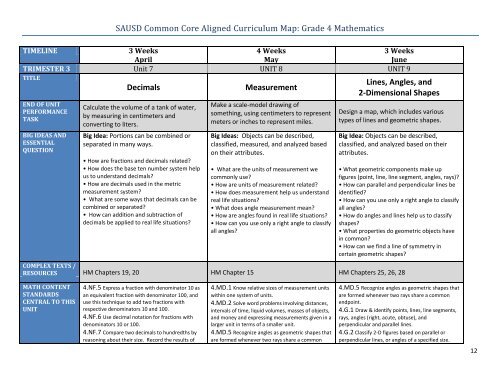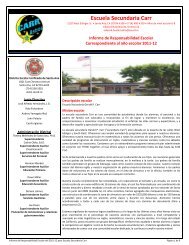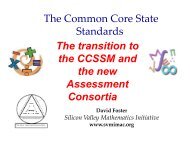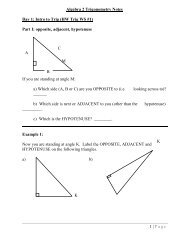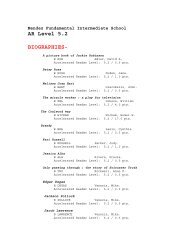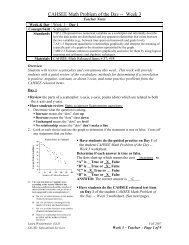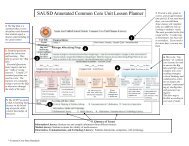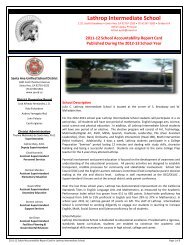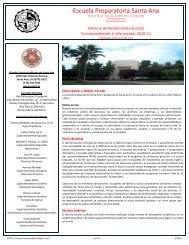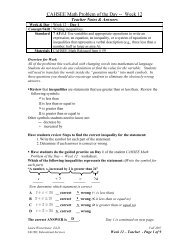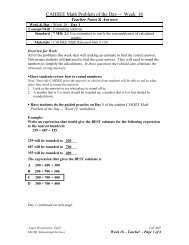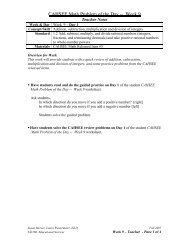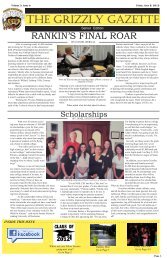2013-2014 Curriculum Map Grade 4 Math
2013-2014 Curriculum Map Grade 4 Math
2013-2014 Curriculum Map Grade 4 Math
Create successful ePaper yourself
Turn your PDF publications into a flip-book with our unique Google optimized e-Paper software.
SAUSD Common Core Aligned <strong>Curriculum</strong> <strong>Map</strong>: <strong>Grade</strong> 4 <strong>Math</strong>ematicsTIMELINE3 Weeks4 Weeks3 WeeksAprilMayJuneTRIMESTER 3 Unit 7 UNIT 8 UNIT 9TITLEEND OF UNITPERFORMANCETASKBIG IDEAS ANDESSENTIALQUESTIONDecimalsCalculate the volume of a tank of water,by measuring in centimeters andconverting to liters.Big Idea: Portions can be combined orseparated in many ways.• How are fractions and decimals related?• How does the base ten number system helpus to understand decimals?• How are decimals used in the metricmeasurement system?• What are some ways that decimals can becombined or separated?• How can addition and subtraction ofdecimals be applied to real life situations?MeasurementMake a scale-model drawing ofsomething, using centimeters to representmeters or inches to represent miles.Big Ideas: Objects can be described,classified, measured, and analyzed basedon their attributes.• What are the units of measurement wecommonly use?• How are units of measurement related?• How does measurement help us understandreal life situations?• What does angle measurement mean?• How are angles found in real life situations?• How can you use only a right angle to classifyall angles?Lines, Angles, and2-Dimensional ShapesDesign a map, which includes varioustypes of lines and geometric shapes.Big Idea: Objects can be described,classified, and analyzed based on theirattributes.• What geometric components make upfigures (point, line, line segment, angles, rays)?• How can parallel and perpendicular lines beidentified?• How can you use only a right angle to classifyall angles?• How do angles and lines help us to classifyshapes?• What properties do geometric objects havein common?• How can we find a line of symmetry incertain geometric shapes?COMPLEX TEXTS /RESOURCES HM Chapters 19, 20 HM Chapter 15 HM Chapters 25, 26, 28MATH CONTENTSTANDARDSCENTRAL TO THISUNIT4.NF.5 Express a fraction with denominator 10 asan equivalent fraction with denominator 100, anduse this technique to add two fractions withrespective denominators 10 and 100.4.NF.6 Use decimal notation for fractions withdenominators 10 or 100.4.NF.7 Compare two decimals to hundredths byreasoning about their size. Record the results of4.MD.1 Know relative sizes of measurement unitswithin one system of units.4.MD.2 Solve word problems involving distances,intervals of time, liquid volumes, masses of objects,and money and expressing measurements given in alarger unit in terms of a smaller unit.4.MD.5 Recognize angles as geometric shapes thatare formed whenever two rays share a common4.MD.5 Recognize angles as geometric shapes thatare formed whenever two rays share a commonendpoint.4.G.1 Draw & identify points, lines, line segments,rays, angles (right, acute, obtuse), andperpendicular and parallel lines.4.G.2 Classify 2-D figures based on parallel orperpendicular lines, or angles of a specified size.12


